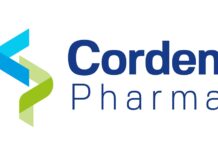Roche announced that the Phase III EMILIA study of trastuzumab emtansine met its co-primary endpoint, of a significant improvement in the time patients with HER2-positive metastatic breast cancer (mBC) lived without their disease getting worse. The study showed that the risk of disease worsening or death was reduced by 35 percent for people who received trastuzumab emtansine compared to those who received lapatinib plus Xeloda® (capecitabine) chemotherapy (HR=0.65, p-value <.0001). The EMILIA study is the first randomised Phase III trial of trastuzumab emtansine in patients with HER2-positive mBC who had previously received Herceptin® (trastuzumab) and a taxane chemotherapy.
There was also a trend for patients who received trastuzumab emtansine to live longer (overall survival, or OS, the other co-primary endpoint of the study) than those who received lapatinib plus Xeloda, but these data are currently not mature. The safety profile of trastuzumab emtansine was consistent with that seen in previous studies, with fewer patients who received trastuzumab emtansine experiencing Grade 3 or higher (severe) adverse events (AEs) than those who received lapatinib plus Xeloda (40.8 percent compared to 57 percent).
The EMILIA data will be presented in the plenary session at the 48th Annual Meeting of the American Society of Clinical Oncology (ASCO) in Chicago by Kim Blackwell, M.D., Duke University School of Medicine (Abstract #LBA1, Sunday 3 June at 1:45 pm CDT). The EMILIA data were also featured in the official ASCO press programme on Saturday 2 June.
“The encouraging efficacy, safety profile and quality of life results from the EMILIA study support our belief that trastuzumab emtansine may have an important role for patients with HER2-positive metastatic breast cancer,” said Hal Barron, M.D., Chief Medical Officer and Head, Global Product Development. “We are working with global regulatory authorities to submit these data as quickly as possible and hope that trastuzumab emtansine will soon be available to patients with this aggressive type of breast cancer.”
Based on the EMILIA findings, Roche and Genentech plan to submit applications for trastuzumab emtansine in HER2-positive mBC this year to the European Medicines Agency (EMA) and US Food and Drug Administration (FDA).
Trastuzumab emtansine is an investigational medicine known as an antibody-drug conjugate (ADC). It is comprised of the antibody trastuzumab and the chemotherapy DM1 attached together using a stable linker. Trastuzumab emtansine is designed to target and inhibit HER2 signalling and deliver the chemotherapy directly inside HER2-positive cancer cells.
Study results
The results presented at ASCO represent the final analysis of PFS and the first interim analysis of OS.
There was a significant improvement in the time patients receiving trastuzumab emtansine (n=495) lived without their disease getting worse compared to those who received lapatinib plus Xeloda (n=496), as assessed by an independent review committee: median PFS was 9.6 months versus 6.4 months, respectively.
The first interim OS analysis demonstrated a trend towards improved OS in patients receiving trastuzumab emtansine versus those who received lapatinib plus Xeloda: median OS was 23.3 months for patients who received lapatinib plus Xeloda but had not been reached for patients receiving trastuzumab emtansine and requires longer follow-up (HR=0.62; P=0.0005).
As the hazard ratio for OS did not cross the pre-specified stopping boundary for the study, the OS analysis is not considered statistically significant at this time. The final analysis is expected to take place by 2014.
One-year survival in patients who received trastuzumab emtansine was 84.7 percent versus 77.0 percent for patients who received lapatinib plus Xeloda. Two-year survival was 65.4 percent versus 47.5 percent, respectively.
The response rate (the percentage of patients with tumour shrinkage) was 43.6 percent for those who received trastuzumab emtansine versus 30.8 percent of patients who received lapatinib plus Xeloda.
The time-to-symptom progression, a patient-reported measure of quality of life, was also improved in patients who received trastuzumab emtansine: 7.1 months in patients who received trastuzumab emtansine versus 4.6 months in patients who received lapatinib plus Xeloda.
Fewer patients who received trastuzumab emtansine experienced Grade 3 or higher (severe) AEs than those who received lapatinib plus Xeloda, at 40.8 percent versus 57 percent, respectively. For people receiving trastuzumab emtansine, compared to those receiving lapatinib plus Xeloda, the most common (occurring in more than 2 percent of patients) Grade 3 or higher AEs were low platelet count (12.9 percent versus 0.2 percent), increased levels of enzymes released by the liver and other organs (in most patients these levels had returned to normal by the time of the next dose of trastuzumab emtansine; aspartate aminotransferase: 4.3 percent versus 0.8 percent; alanine aminotransferase: 2.9 percent versus 1.4 percent) and anaemia (2.7 percent versus 1.6 percent).
For those patients receiving lapatinib plus Xeloda compared to those receiving trastuzumab emtansine, the most common Grade 3 or higher AEs were diarrhoea (20.7 percent versus 1.6 percent), hand-foot syndrome (16.4 percent versus 0) and vomiting (4.5 percent versus 0.8 percent).
About the EMILIA study
EMILIA (TDM4370g/BO21977) is an international, Phase III, randomised, open-label study comparing trastuzumab emtansine alone to lapatinib in combination with Xeloda in 991 patients with HER2-positive locally advanced or metastatic breast cancer whose disease progressed after initial treatment with Herceptin and a taxane-based chemotherapy.
Participants in the trastuzumab emtansine arm received:
Trastuzumab emtansine 3.6 mg/kg dose every three weeks
Participants in the lapatinib plus Xeloda arm received:
Lapatinib 1250 mg dose daily, every three weeks.
Xeloda 1000 mg/m2 dose, twice daily, days 1 – 14, every three weeks.
The co-primary efficacy endpoints of the study are PFS (as assessed by an independent review committee) and OS. Safety is also a primary endpoint of the study. Other study endpoints include and one-year and two-year survival rates, safety profile, PFS as assessed by investigator, objective response rate, duration of response and quality of life.
About trastuzumab emtansine
Trastuzumab emtansine is an ADC being studied in HER2-positive cancers. It is comprised of the antibody trastuzumab and the chemotherapy agent DM1 attached together using a stable linker. Trastuzumab emtansine is designed to target and inhibit HER2 signalling and deliver the chemotherapy agent DM1 directly inside HER2-positive cancer cells. Trastuzumab emtansine binds to the HER2-positive cancer cells, and is thought to block out-of-control signals that make the cancer grow while also calling on the body’s immune system to attack the cancer cells. Once trastuzumab emtansine is absorbed into those cancer cells, it is designed to destroy them by releasing the DM1.
In addition to EMILIA, there are two ongoing Phase III studies of trastuzumab emtansine:
MARIANNE is comparing three different regimens (trastuzumab emtansine alone, trastuzumab emtansine plus pertuzumab, and Herceptin plus a taxane chemotherapy) in patients with HER2-positive mBC who have not been previously treated for their metastatic disease.
TH3RESA is comparing trastuzumab emtansine to physician’s choice of treatment in people with HER2-positive mBC who have already received both Herceptin and lapatinib.
Genentech, a member of the Roche Group, licenses technology for trastuzumab emtansine under an agreement with ImmunoGen, Inc.
Building on the results of trastuzumab emtansine studies to date, Roche/Genentech have approximately 25ADCs in the pipeline.
About breast cancer
Breast cancer is the most common cancer among women worldwide. Each year about 1.4 million new cases of breast cancer are diagnosed worldwide, and over 450,000 women will die of the disease annually.In HER2-positive breast cancer, increased quantities of the human epidermal growth factor receptor 2 (HER2) are present on the surface of the tumour cells. This is known as “HER2 positivity” and affects approximately 15-20 percent of women with breast cancer.HER2-positive cancer is a particularly aggressive form of breast cancer.
About Roche
Headquartered in Basel, Switzerland, Roche is a leader in research-focused healthcare with combined strengths in pharmaceuticals and diagnostics. Roche is the world’s largest biotech company with truly differentiated medicines in oncology, virology, inflammation, metabolism and CNS. Roche is also the world leader in in-vitro diagnostics, tissue-based cancer diagnostics and a pioneer in diabetes management. Roche’s personalised healthcare strategy aims at providing medicines and diagnostic tools that enable tangible improvements in the health, quality of life and survival of patients. In 2011, Roche had over 80,000 employees worldwide and invested over 8 billion Swiss francs in R&D.




















